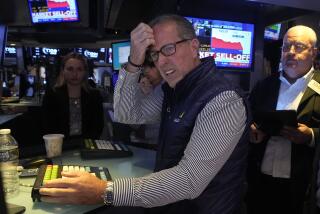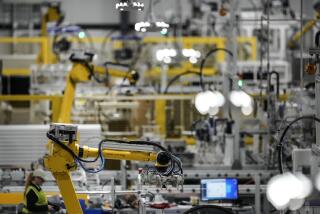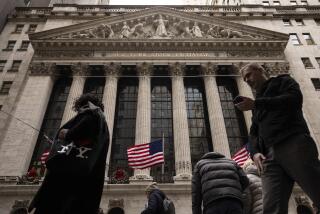Some Economists See Risk of a Downturn
- Share via
The U.S. economy hasn’t yet convincingly rebounded from the summer’s soft patch, although some economists expect a pickup.
But could it get worse instead and even turn into a recession?
Relatively few economists are using the R-word outright. More and more, however, are beginning to warn that a downturn can’t be dismissed.
The latest to issue such an alert is the widely watched UCLA Anderson Forecast. In its latest quarterly outlook, to be formally released this morning, the group calls a recession a “distinct possibility” in the next two years.
Though the odds of such an unpleasant event still are slight -- only 10% -- “a recession is more likely than the economy taking off,” said Michael Bazdarich, UCLA Anderson Forecast senior economist and author of the national part of its outlook.
Some other economists put the odds of a recession much higher. But UCLA Anderson Forecast’s mention of recession risk is notable because its less optimistic stance in recent years has proved to be prescient. It was among the first to predict the 2001 recession and to anticipate the current soft patch.
The quarterly outlook calls for the U.S. economy to grow at 3.3% inflation-adjusted rates in both 2005 and 2006. That’s not much better than the 2.8% annualized growth rate posted in the second quarter and down from the first quarter’s 4.5% rate.
“This is as good as it’s going to get,” Bazdarich said, noting that the all-important consumer and housing sectors don’t have the steam to spark faster growth.
Talk of a recession comes at a politically sensitive time. The presidential election is riding partly on voters’ perception of whether the economy is getting better, as President Bush contends, or worse, as Democratic challenger Sen. John F. Kerry would have Americans believe.
It’s also a sensitive time for monetary policy. The Federal Reserve has been raising its benchmark short-term interest rate on the assumption that growth will pick up, or at least not slow further. The central bank is expected to raise rates again at its next meeting Sept. 21.
Perhaps most important, if consumers or businesses fear a downturn, their resulting caution could trigger one. Indeed, that often is how recessions begin.
To be sure, with a nearly 3% annualized growth rate, the economy is far from recession, often defined as two consecutive quarters of economic contraction. (The 2001 recession started in March and ended in November, according to the National Bureau of Economic Research.) Many mainstream economists, including UCLA’s, call for continued annual growth of at least 3%. Some predict growth to return closer to the 4.5% pace posted in this year’s first three months.
Upbeat forecasters base their view on several factors, including low interest rates, business optimism, a revival of consumer spending and a decline in gasoline prices. One optimist, Fed Chairman Alan Greenspan, has blamed the recent slowdown on “transitory” factors, such as the record-high gasoline prices seen a few weeks ago.
However, the potential for further energy inflation also has stoked recession concerns, said Steven A. Wood, chief economist for Danville, Calif.-based Insight Economics, which conducts weekly surveys of about 50 business economists.
They are generally putting the odds of a recession at 25% to 33% in the next one or two years, he said.
And Economy.com, a West Chester, Pa., research firm, said its recession indicator in August put the risk of a downturn at 32.7% in the next six months, up from 25.7% in July -- and only 7.6% in March. A rise above 50% indicates a probable recession; the indicator last rose above 50% a few months before the 2001 slump, Economy.com chief economist Mark Zandi said.
The two main factors driving the higher recession risk are weaker financial market conditions -- as shown by a sluggish stock market and falling bond-market interest rates -- and declining consumer and business confidence, he said.
“We’re not near recession territory yet, but there has been a measurable weakening in economic activity,” Zandi said.
Recession risks also have risen because the economy’s safety nets have lost strength, Wood said. The Fed can’t cut its benchmark short-term rate much lower than the 1% it stood at back in June. President Bush’s tax cuts have used up their stimulative effects. Debt-laden consumers and governments are not in financial shape to significantly turn up their spending spigots.
So an economic shock from a huge sustained jump in gasoline prices or a devastating terrorist attack could trigger a recession, Wood said.
“If the soft patch were to turn into something more severe, there is not a lot of ammunition to fight back with,” Wood said.
UCLA forecasters’ concern is a bit different. Their worry: The current recovery is vulnerable because of old age.
Although the expansion officially started in 2001, the consumer and housing sectors haven’t been in recession since 1990, so their recoveries are actually 14 years old, Bazdarich said.
An aged recovery masquerading as a youthful one is akin to “an 80-year-old in [actress] Meg Ryan’s body,” he said.
Although expansions -- such as those of the 1980s and 1990s -- can last an entire decade, going beyond that is pressing their luck, he said.
Consumers have spent their cash from Bush tax cuts and the mortgage refinancing boom, probably anticipating that a continued strong economy would allow them to pay down debts later while sustaining spending, Bazdarich said. But if they perceive that the soft patch will stick around, they might reel in spending to pay down debts.
With consumer spending accounting for two-thirds of economic activity, that could spark a recession, he said.
“There is not really much upside for consumers from here,” Bazdarich said.
The UCLA forecast for California, largely unchanged from its last report in June, is a bit more upbeat. It calls for “faster but not-yet-rapid growth” in 2005 and 2006.
The state’s growth in nonfarm payroll jobs will outpace the nation’s, the report says, rising from 0.8% this year to 2% in 2005 and 2.1% in 2006.
More to Read
Inside the business of entertainment
The Wide Shot brings you news, analysis and insights on everything from streaming wars to production — and what it all means for the future.
You may occasionally receive promotional content from the Los Angeles Times.










